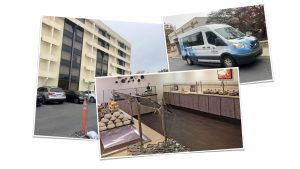On a recent Wednesday evening, the Durham Bicycle and Pedestrian Advisory Commission gathered to talk about cul de sacs, bike paths and sidewalks.
From the comfort of their Durham homes, committee members and residents met by Zoom, discussing pedestrian and cyclist safety. Starting with a general statement “affirming BPAC’s commitment to equity and racial justice,” the committee dove into updates and action plans.
The group advises the City Council and Board of County Commissioners on bicycle and pedestrian issues. Its 18 volunteer members are evenly divided between representatives from the city and county. The group advocates for more sidewalks and bike lanes, better trail maintenance, bike racks, lower speed limits and free bike helmets, among other things.
Committee members are passionate about biking, walking and maintaining the character of Durham neighborhoods.
As Tyler Dewey, the Duke liaison for the group, put it in a recent interview with Bike Durham, “we must build for a people-centered future, rather than our car-dependent present.”
But that “people-centered future” is only attainable with some serious action by policymakers, which gives the committee’s work potential importance.
Although the board had a full agenda for this meeting, none of it was particularly controversial – roll call, safety lecture, infrastructure bonds descriptions and the like. The most lively moment came at the beginning, when Durham resident Brittany Mosesso spoke during the citizen comment period.
Mosesso and her husband have two sons, 1 and 3 years old. She had come across the committee’s website while seeking answers to concerns about the safety for children in her Hope Valley neighborhood. She said she wanted “nicer ways to move around [her] community that doesn’t involve adding more cars on the street.”
Mosesso said she sometimes felt “trapped” in her cul de sac off of Dixon Road because of speeding cars. Most don’t follow the 25 mph speed limit, and the road lacks a shoulder, sidewalk and bike path.
Mosesso said when she thinks about the dangers, “that’s where I really get the fire in me.”
She wondered if she should join the committee to represent other “complaining moms.” After the meeting, she was invited to a subcommittee meeting and given roughly an hour to discuss her concerns and potential solutions.
Joined by city representatives, the group gave her connections and recommendations. Although sidewalks are pricey and can take years, the group gave her ideas about establishing walking paths with property owners and connecting with other people in her neighborhood. With enough collective interest in her neighborhood in the future, the committee would then support the new neighborhood paths and endorse them to local authorities.
She said this less-formal approach consists of “a lot of smaller steps to get towards a future state,” that gives her flexibility to work with her neighbors and create a safer environment.
Mosesso described her goals as somewhat of a “selfish ulterior motive,” but committee Chair Deniz Aydemir said that approach is needed for the group to succeed.
Aydemir said people like Mosesso are crucial to making streets and sidewalks safer. He said, “you just gotta find that advocate.”








